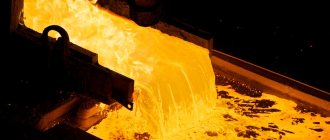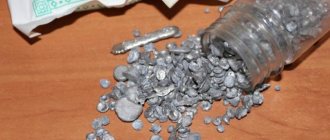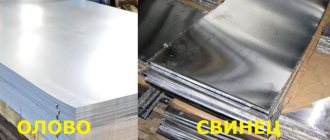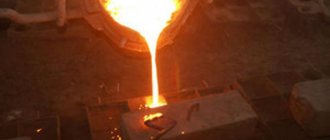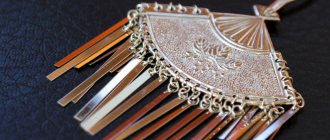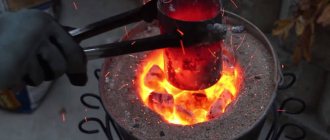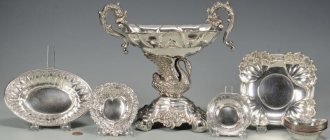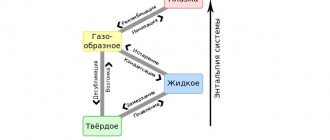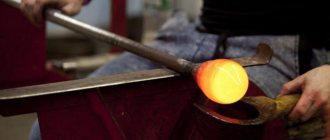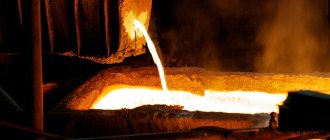Thin films
The resistance of thin flat films (when its thickness is much less than the distance between the contacts) is usually called “resistivity per square”, RSq.{\displaystyle R_{\mathrm {Sq} }.} This parameter is convenient because the resistance of a square piece of conducting film is not depends on the size of this square, when voltage is applied on opposite sides of the square. In this case, the resistance of a piece of film, if it has the shape of a rectangle, does not depend on its linear dimensions, but only on the ratio of the length (measured along the current lines) to its width L/W
: RSq=RWL,{\displaystyle R_{\mathrm {Sq } }=RW/L,} where
R
is the measured resistance. In general, if the shape of the sample is different from rectangular and the field in the film is non-uniform, the van der Pauw method is used.
INTERNATIONAL BRANDS
Melting point of aluminum
Kh23Yu5T - 875 (W-KA1) contains 22% Cr, 72.2% Fe, 5.8% AL, melting temperature. 1500 °C. International name: eurofechral, Kanthal D, Alloy 815, Alchrome DK, Resistohm 135, megapir, Aluchrom 5, GS SY. Similar grades: OCr25Al5, 1Cr13AL4, OCr15Al5.
Kanthal D (Х21У) contains 22% Cr, 73.2% Fe, 4.8% Al, melting point 1500 °C. International name: eurofechral, Kanthal D, Alloy 815, Alchrome DK, Resistohm 135, megapir, Aluchrom 5, GS SY. Similar grades: OCr27Al7Mo2, OCr15Al5, OCr21Al6Nb, FeCrAl+Y.
Provider
The supplier "Auremo" offers to buy fechral in bulk or in installments. Large selection of semi-finished products in stock. Optimal price of fechral from the supplier. Buy fechral today. For wholesale customers, the price of fechral is preferential.
Basic qualities
Melting point of silumin
This alloy combines a high melting temperature of 1500 °C and significant electrical resistance: up to 1.3 Ohmxmm2/m. The relatively low density (7.2 g/cm³) makes the alloy 17% lighter than nichrome. Thanks to the use of inexpensive aluminum instead of scarce nickel, production costs are reduced by 6 times compared to nichrome. Fechral is characterized by high corrosion resistance in vacuum, air, carbon-containing and oxidizing, sulfuric environments. The Achilles heel of fechral is its fragility, which makes it difficult to make thin ribbons and wires from it. This drawback is eliminated by adding nickel additives, but then the price of the product increases.
| Alloy | Si | C | Cr | Mn | Fe | Al | Ti | Ni |
| Х23У5Т | ≤0.50 | ≤0.05 | 22.0−24.0 | ≤0.30 | remainder | 5.00−5.80 | 0.2−0.5 | ≤0.60 |
| Х23У5 | ≤0.60 | ≤0.05 | 21.5−23.5 | ≤0.30 | remainder | 4.60−5.30 | 0.15−0.40 | ≤0.60 |
| Х13У4 | ≤0.70 | ≤0.08 | 13.5−15.5 | ≤0.70 | remainder | 4.00−5.50 | 0.2−0.6 | ≤0.60 |
| Х15У5 | ≤0.70 | ≤0.08 | 14.5−15.5 | ≤0.70 | remainder | 4.50−5.50 | 0.2−0.6 | ≤0.60 |
Nichrome: description and characteristics
Nichrome
is the general name for a group of alloys that have a high percentage of nickel (Ni) and chromium (Cr) in their chemical composition, hence the name. Depending on the need to improve certain mechanical properties, in addition to nickel and chromium, other elements can be added, for example, iron, aluminum, silicon or manganese.
There are two main types of nichromes:
- Nichrome 80 (Nichrome 80) or non-ferrous - a precision alloy, the chemical composition of which is 80% nickel and 20% chromium (Ni-Cr);
- Nichrome 60 (Nichrome 60) or ferrous is a precision alloy, the chemical composition of which is 60% nickel, 16% chromium and 24% iron (Ni-Cr-Fe).
These two types of nichrome differ in the percentage ratio of nickel/chrome and the presence of iron in the chemical composition, which affects the resistivity indicators. Among the most popular Nichrome brands are Ni80Cr20, Ni70Cr30, Ni60Cr15, Ni40Cr20, Ni30Cr20 and Ni20Cr25.
Main properties of nichrome:
- maximum operating temperature – 11000С; melting point of nichrome – 11000С-14000С;
- resistance to aggressive environments;
- excellent indicators of plasticity and creep resistance;
- high heat resistance in an oxidizing atmosphere (up to 12500C);
- low temperature coefficient of expansion;
- excellent weldability;
- high resistivity;
- corrosion resistance and durability.
It is worth noting that nichrome products conduct thermal energy well, so wire, rods, tapes, strips, and heating coils are made from nichrome grades.
This rolled metal is used in:
- production of heating elements in electric furnaces, kilns, burning devices;
- industrial ventilation dryers;
- boilers and heat exchangers;
- production of electrical wires;
- production of parts that operate at high temperatures, for example, rheostats;
- manufacturing of electronic cigarettes.
Constantan
Alloy of 60% copper and 40% nickel. Constantan has a resistivity of 0.5 Ohm × mm² / m, density 8.9 kg/dm³, tensile strength 40 - 50 kg/mm².
Constantan is used for the manufacture of rheostats and electric heating resistances if their operating temperature does not exceed 400 - 450 °C.
Constantan in combination with copper has a high thermal emf and therefore cannot be used to make standard resistances for precision instruments, since this additional emf will distort the instrument readings. This property of constantan is used in the manufacture of thermocouples to measure temperatures of the order of several hundred degrees.
The alloy for rheostats or resistances must be cheap, have a high resistivity and a low temperature coefficient of resistance. For these purposes, copper-based alloys are used, such as constantan, nickel and others.
To reduce the cost of the material, nickel in rheostatic alloys is replaced by zinc and iron. Alloys used for electric heating devices and furnaces must be well processed, mechanically strong, cheap, have high resistivity, and operate for a long time at high temperatures without oxidation.
When a metal is heated, an oxide film forms on its surface, which should prevent further destruction of the metal. Metals - copper, iron and cobalt - have a porous oxide film, so when heated they quickly collapse. Metals such as nickel, chromium and aluminum are coated with a dense oxide film when heated, so heat-resistant alloys are made based on these metals.
About heaters and materials for their production
The heater is the main element of the furnace, since its main function is heating. The performance of the entire installation depends on its serviceability and ability to withstand high temperatures. There are a number of requirements for heaters. Read more about them.
Heaters must have the following characteristics:
- high heat resistance - the ability to resist gas corrosion during heating to high temperatures;
- sufficient heat resistance - the ability of a material to maintain its mechanical strength when heated.
Basic properties of heater materials
Materials used for the production of electric furnace heaters must have high electrical resistivity. The ability of the element to heat up depends on this value. If for the manufacture of a heater you choose a material whose ohmic resistance is lower, then to achieve a similar result its length will have to be increased and its cross-section reduced. But, more often than not, large furnaces do not allow the installation of elements of different sizes. Also, it is worth noting that the service life of the heater depends on the diameter. Therefore, in most cases, heating elements are made of materials with high electrical resistance, such as:
- nichrome grades Х20Н80, Х15Н60;
- fechral grade X23Yu5T.
These chromium-nickel and iron-chromium-aluminum alloys are precision alloys, which are characterized by high ohmic resistance and other characteristics necessary to obtain high-quality heaters.
When choosing a material for the manufacture of a heater, its temperature coefficient of electrical resistance is also taken into account. It is best if this value is small. Since it is an indicator of how much the electrical resistance of the material will change during the heating process. If this coefficient is high, then turning on the furnace and bringing it out of the cold state is carried out at a reduced voltage, for which it is necessary to use a special step-down transformer.
It is very important that the physical properties of the heater material are constant. For example, if you choose carborundum for its production, then after a certain period of time it can change the electrical resistance, which will complicate the process of its operation
In order to stabilize this parameter, it will be necessary to use a multi-stage transformer with an extended voltage range.
The metal materials from which heaters are made must have such technological parameters as ductility and weldability, since thanks to them the process of manufacturing heating elements of complex configurations is facilitated. Non-metals can also be used for such purposes. The non-metallic heater is pressed or formed.
Heater materials
Most often, precision alloys with high electrical resistance are used to manufacture heaters. These include chromium-nickel (nichrome grades X20N80, X20N80-N, X15N60, X15N60-N) and iron-chromium-aluminum (feral grades X23Yu5T, X27Yu5T, X23Yu5, X15Yu5, X15N60Yu3, X27N70YUZ) alloys.
The above alloys are characterized by high heat resistance and heat resistance. They can heat up and operate at high temperatures. The heat resistance property is provided by the chromium oxide film that forms on the surface of the material. Its melting point is higher than that of the alloy. The chromium oxide film prevents the element from cracking during heating and cooling.
Let's compare the main alloys for the manufacture of heaters - nichrome and feral, considering their advantages and disadvantages.
Resistivity - Aluminum
| Specific electrical resistance of the winding conductor material. |
The specific resistance of aluminum after being forced into the rotor grooves increases slightly due to the formation of a certain number of shells (air inclusions) and a change in the structure during cooling in narrow grooves or sections of the groove. Therefore, in calculations we take the resistivity of the cast aluminum winding of the rotors of asynchronous motors equal to 10 ( / 21 5 Ohm m at a temperature of 75 C and 10 - 6 / 20 5 Ohm m at a temperature of 115 C.
| Towards the calculation of the magnetic conductivity coefficient of slot scattering. |
The specific resistance of aluminum after pouring into the grooves of the machine increases slightly due to the formation of a certain number of shells (air inclusions) and a change in the structure during cooling in narrow grooves.
| Specific electrical resistance of the winding conductor material. |
The specific resistance of aluminum after pouring into the rotor grooves increases slightly due to the formation of a certain number of shells (air inclusions) and a change in the structure during cooling in narrow grooves or sections of the groove. Therefore, in calculations we take the resistivity of the cast aluminum winding of the rotors of asynchronous motors equal to 10 - / 21 5 Ohm - m at a temperature of 75 C and KN / 20 5 Ohm - m at a temperature of 115 C.
The resistivity of aluminum is higher than the resistivity of copper, but since the density of aluminum is 2 70, and the density of copper is 8 94, an aluminum wire, the length and mass of which is the same as the length and mass of the copper wire, will have a conductivity 2 04 times greater, than copper wire. This fact is the reason why aluminum is used as wires in power lines instead of copper.
A numerical analysis of the temperature dependence of the ideal resistivity of aluminum, copper, silver and nickel in the range 4 2 - 78 K was carried out.
Unlike copper, annealing practically does not change the resistivity of aluminum. The temperature coefficient of resistance of aluminum is approximately the same as that of copper.
Oxidized aluminum wire has a heat resistance of up to 400 C, but the resistivity of aluminum is 1.65 times that of copper. In addition, oxide insulation has low electrical strength (150 - 200 V) due to the very small thickness of the oxide layer, and increased hygroscopicity. Therefore, the oxide insulation must be impregnated with suspensions based on fluoroplastic-4. Impregnated oxide insulation has a heat resistance of 250 - 300 C. To form oxide insulation, copper wires must be coated with a thin layer of aluminum.
Oxidized aluminum wire has a heat resistance of up to 400 C, but the resistivity of aluminum is 1 65 times greater than that of copper. In addition, oxide insulation has low electrical strength (150 - 200 V), due to the very small thickness of the oxide layer, and increased hygroscopicity. Therefore, the oxide insulation must be impregnated with suspensions based on fluoroplastic-4.
In squirrel-cage motors, the rotor winding is not isolated from the core, since, due to the significant difference between the resistivities of aluminum and steel, the induced currents arising in the winding are mainly closed along its rods and rings.
Uek - economic current density, A / mm2; sincp - power factor / and load before compensation; p—resistivity of aluminum, Ohm—m2/km; / — line length, km; k APM HOM / SHOM - relative losses in copper of the transformer at its rated load; (Zt is the load factor of the transformer.
| Applying oxide insulation to aluminum wires. |
Coils are made from oxidized aluminum that have the ability to operate at high operating temperatures; the ability to load the wire with a high-density current, together with the small thickness of the oxide insulation, can significantly compensate for the increase in the resistivity of aluminum compared to copper (see page. In some cases, great advantages (the possibility of automating production, improving cooling conditions) are provided by the manufacture of windings not from round wires, but from a wide aluminum strip, anodized and then wound onto the core.
The main advantages and disadvantages of nichrome
Let's talk about the advantages of crafts that were made using nichrome. They are similar to fechral, but there are some differences.
- Can be used effectively in high-heat environments.
- Due to the composition of the components, the product can easily withstand several cycles of the heating procedure.
- Increased elasticity allows the material to be used without additional heating.
- The maximum value of resistance to electricity is 1.1 Ohm×mm²/m.
- The structure of the element contains components that are little susceptible to oxidative processes.
- The operating temperature is 1100 °C. If the main component is iron, then the value decreases to 800 °C.
- Since the composition contains a minimal amount of iron or is completely absent, the magnetic function is almost zero.
- A large margin of safety allows nichrome to withstand the influence of an acid-aggressive environment.
The main disadvantage of the base is that it is expensive to produce. There are more budget options, for example, fechral.
The product also has a high density (8500 kg/m3), which affects its heat output. Compared to the fechral kit, it is much lower.
Let's conduct a comparative analysis of the two foundations
Properties of fechral wire grades X15Yu5 and X23Yu5T
Fechral is an ideal alloy, characterized by high heat resistance (withstands temperatures up to 1450 ° C) and significant ohmic resistance, the value of which is 1.2-1.3 Ohm × mm2/m and remains unchanged when heated. Thanks to these properties, the alloy has become indispensable in the manufacture of heating elements. In addition, fechral wire has other advantages, such as:
- high anti-corrosion properties in various environments;
- low specific gravity – 7.2 g/cm3;
- large margin of turnover;
- high resistance to mechanical loads;
- relatively low cost.
Fechral wire has disadvantages. These include fragility, which affects the production of small-diameter tape and wire from this alloy and complicates the manufacturing process itself. This disadvantage is eliminated with the help of nickel or additives with similar properties. The introduction of additives into the alloy composition affects its final cost - it increases.
Features of marking fechral wire
Fechral wire is marked depending on its main purpose using the following letters:
- H – heating elements;
- C – resistance elements;
- Heating elements are elements of tubular electric heaters.
As for the diameter of the fechral wire, it is represented by a number of standard values, ranging from 0.1 to 10 mm.
Features of fechral wire production
Since the alloy is brittle, it is impossible to produce wire by cold working. Thread drawing is carried out in accordance with special energy-intensive technologies, which are reflected in the bed price of rolled metal. In most cases, fechral wire is produced by drawing or pressing. Such material is shipped in coils or coils. The industrial demand for fechral wire is significant. The material has advantageous consumer properties, excellent technical characteristics, and at the same time its cost remains relatively low. Fechral is gradually replacing nichrome. The properties of the alloys are practically similar, but the reduction in the cost of the first is due to the introduction of aluminum into its composition, instead of expensive nickel. As for the price of fechral wire, it directly depends on the diameter of the rolled metal.
Buy at a good price
offers you to purchase rolled metal of heat-resistant alloys on favorable terms. A significant range of products is located directly in the warehouse, which makes it possible to speed up the delivery of purchased material. The products sold have appropriate certificates. guarantees high quality of supplied products. It is profitable to work under the proposed conditions for both wholesale and retail buyers.
===============================================
Fechral wire grades X15Yu5 and X23Yu5T
Welding
To connect fechral spirals, it is best to use argon arc welding with a tungsten electrode with direct current. As a rule, fechral or food grade stainless steel is also used as an additive. This method guarantees high quality welds when using direct current of straight polarity. Tungsten non-consumable electrodes are manufactured in accordance with GOST 23 949−80. Consumable tungsten carbide electrodes are standardized by GOST 21 448−75. Electrodes of this type can be either round (with parameters from 0.5 to 3x40 mm) or flat (4x2x40, 1.5x2x40, 1.5x3x40). The characteristics of tungsten carbide electrodes and the manufacturing technology of such a composition provide excellent operational durability and high thermal stability of the welding arc.
Types of fechrals
The product belongs to the group of alloys with increased resistance to electricity.
Fechral X23Yu5T is used in electric heating equipment, industrial ovens, and also in electronic cigarettes as one of the types of heating elements. It has high electrical resistance, which makes the composition unique. The maximum possible heating temperature is 1450 °C.
Percentage of components: 24% chromium, about 70% iron, up to 6% aluminum and a little titanium (maximum 0.4%).
Fechral X27Yu5T is similar in function to the previous solution, with the exception of the melting point and other options. Its threshold is 1350 °C, and the percentage is 28% chromium, 6% aluminum and 68% iron.
The third option is a weaker version of the above two. It is used to make resistors. Its operating temperature is up to 900 °C.
Chemical composition of the main brands of nichrome and fechral
Nichrome
The basic chemical composition of nichrome contains about 55-80% nickel (Ni), 13-23% chromium (Cr), up to 1.5 manganese (Mn), plus a small amount of impurities. There are two types of nichrome - non-ferrous (which contains no more than 1.5% iron) and ferrous (containing up to 75% nickel, 13-18% chromium and up to 5-6% iron).
Nichrome brands Х20Н80 (Х20Н80-Н) and Х15Н60 (Х15Н60-Н) The popular brand of nichrome Х20Н80 belongs to the non-ferrous type, and in accordance with GOST 10994-74 contains 20-23% chromium (Cr), 75-80% nickel (Ni). The rest of the X20N80 alloy is occupied by up to 1.5% iron (Fe), up to 0.9-1.5% silicon (Si), up to 0.7% manganese (Mn), less than 0.3% titanium (Ti), 0 .2% aluminum (Al) and 0.1% carbon (C), plus negligible amounts of phosphorus (P) and sulfur (S). The grade of nichrome X15N60 belongs to the ferrous type of alloy and therefore the concentration of iron in its composition according to GOST reaches 5-6%, with 55-61% nickel (Ni) and 15-18% chromium (Cr).
Read also: Drilling rig SBR 160
The main component of nichrome is nickel (Ni), which determines the key technological properties of the material. In this regard, based on the X20N80 grade, an “improved” modification of the alloy was created, to designate which the letter “H” was added at the end of the alphanumeric code. It turned out X20N80-N. In accordance with GOST, the volume of chromium (Cr) in the X20N80-N alloy remained the same, and the amount of nickel (Ni) increased slightly due to a reduction in the volume of other components, plus 0.2-0.5 zirconium (Zr) was added. The brand of nichrome X15N60-N was created according to exactly the same principle.
Fechral
In the basic composition of chemical elements, fechral contains up to 70-72% iron (Fe), 12-27% chromium (Cr), 3.5-6% aluminum (Al), up to 1% silicon (Si), 0.7% manganese (Mn), plus a small amount of alloying additives in the form of zirconium (Zr) and titanium (Ti). Fechral has many brands, both domestic and international, allowing you to select the optimal alloy for a variety of purposes and operating conditions.
Fechral brands X23YU5T, X27YU5T, X15YU5 The market in Russia and the CIS today is focused on fechral of three domestic brands: X23YU5T, X27YU5T and X15YU5, which demonstrate the stability of physical characteristics at high temperatures, including in aggressive environments. Among the most popular brands is fechral X23Yu5T (foreign analogues of Kanthal A-1, GSSY). In accordance with GOST 10994-74, the X23Yu5T alloy contains about 70% iron (Fe), 22-24% chromium (Cr) and 5-5.8% aluminum (Al). The remainder includes up to 0.6% nickel (Ni), up to 0.5% titanium (Ti), silicon (Si) and carbon (C), up to 0.3% manganese (Mn), as well as an extremely small amount of calcium (Ca), cerium (Ce), phosphorus (P) and sulfur (S).
Fechral grade X15Yu5 (a foreign analogue of Aluchrom W) is characterized by a higher iron content (up to 77-78%) and a reduced amount of chromium (13.5-15.5%), which makes the alloy more durable and less brittle. The remaining chemical elements are contained in the X15Yu5 alloy within the traditional proportions for fechrals: 4.5-5.8% aluminum (Al), up to 0.6-0.7% silicon (Si), nickel (Ni), manganese (Mn) , titanium (Ti), plus hundredths of a percent of phosphorus (P), sulfur (S), carbon (C), calcium (Ca) and cerium (Ce). It should also be mentioned fechral grade X27Yu5T with a relatively high concentration of chromium (up to 28%), which is rarely produced today and is gradually being replaced by more modern analogues.
Comparison of nichrome with fechral - which is better
The main differences between the alloys are in their composition: the nickel content of nichrome. This imposes the following features on its operational and technological characteristics:
- The resistivity of nichrome is 15% lower, and the density is 16% higher;
- Nichrome is on average 3-5 times more expensive;
- The plasticity of fechral is 2 times less. This allows you to use nichrome more efficiently in your work, making a thinner spiral for electric heaters;
- Better resistance of nichrome to cyclic temperature loads. When operating in frequent on/off mode, the nichrome thread will last longer.
Rating: /5 — votes
Content
Nichrome: description and characteristics
Fechral: description and characteristics
Nichrome and Fechral: what is the difference between the alloys
Nichrome and Fechral
- This is a group of precision alloys that are characterized by high electrical resistance. This explains their main application - the production of heating elements for electrometric equipment. However, despite being related to the same group of alloys and having similar practical applications, these materials have differences in chemical composition and in physical and mechanical properties.
Types of fechrals
| Alloy grade | Compound | Melting temperature | Other names |
| Х27У5Т | 26-28% Chromium, ~65-68% Iron, 5-5.8% Aluminum, 0.15-0.4% Titanium | 1450 °C | |
| Х23У5Т – alloy 875 (W-KA1) | 22-24% Chrome, 69-72% Iron, 5-5.8% Aluminum, 0.15-0.4% Titanium | 1500 °C | Kanthal A1, Alloy 875, Resistohm 145, Aluchrom 0, Alchrome 875, megapir GS SY, eurofechral |
| X23Yu5 - alloy 837 (W-KAF) | 23% Chrome, 71.7% Iron, 5.3% Aluminum | 1500 °C | Kanthal AF, Resistohm Y, Aluchrom Y, Alloy 837, megapir, GS SY, eurofechral |
| Х15У5 | 15% Chrome, 79.7% Iron, 5.3% Aluminum | 1500 °C | Kanthal AF, Resistohm Y, Aluchrom Y, Alloy 837, megapir, GS SY, eurofechral |
Application
Х27У5Т
— for heating elements with a maximum operating temperature of 1350 °C in industrial and laboratory furnaces.
Х23У5Т
- a hard, brittle alloy, difficult to process, has a high electrical resistivity (1.2-1.3 μOhm m). Density 7100–7300 kg/m³, melting point about 1450 °C. The highest operating temperature is 1350–1400 °C. It is used for powerful electric heating devices, laboratory and industrial furnaces. The disadvantages include the general property of fechrals - a recrystallization threshold in the temperature range of 600-650 °C, which makes it difficult to use this alloy in thermal cycling mode, as well as low ductility. Also, this alloy is used as one of the most popular materials for the manufacture of heating coils in electronic cigarettes.
Х15У5
— has a density of 7.1 g/cm³, melting point about 1450 °C. The highest operating temperature is 750–950 °C. It is used for powerful electric heating devices, production of resistor blocks and resistance elements.
GS23-5 (Х23У5Т-Н-Ви)
is an improved version of the X23Yu5T alloy. Thanks to the introduction of a special alloy, it was possible to significantly improve its physical properties, which greatly facilitates the winding of spirals. Withstands operating temperatures up to 1350 °C. The disadvantages include the general property of fechrals - a recrystallization threshold in the temperature range of 600-650 °C, which makes it difficult to use this alloy in a thermocyclic mode.
GS T (Х23У5-Н-Ви)
— widely used in high-temperature electric furnaces, roasting and drying furnaces, various electrical thermal apparatus. Optimal for use in the production of tubular electric heaters (TEH) and household appliances.
Megapir-150
- widely used for the production of resistive elements, in electric furnaces and various electrical thermal devices.
Megapir-200
- used in high-temperature electric furnaces, roasting and drying furnaces, various electrical thermal devices, as well as for the production of resistive elements.
Scope of application
The main application of nichrome is the production of heating elements of increased reliability for electric roasting and drying furnaces for industrial and laboratory purposes, for water and air heating systems, for electric stoves, evaporator filaments for electronic cigarettes, etc. Nichrome is used for the production of rheostats, high-resistance resistances of low and medium power, and for connectors in electronics. Fechral, in turn, is used to create heaters for high-temperature electrothermal equipment capable of heating up to 1400°C, including those operating in high-alumina ceramics and sulfur-containing environments.
Application
The scope of application of fechral is narrowly focused. The solution is produced as a set of components for heating elements. These include various household appliances: for example, a hair dryer or oven.
The composition is also used in production: industrial ovens, laboratories or other equipment that requires elements with resistance to high temperatures.
Increased resistance to active chemicals and a constant braking coefficient during any heating process increase the service life of the final product.
The compact size, thanks to the optimal specific density, allows the products to be used in braking resistors.
Fechral wire Х23У5Т
The most popular rolled metal of this alloy is fechral wire X23Yu5T. It has a high rate of heat resistance and heat resistance. Due to these characteristics, X23YU5T wire is considered to be of much higher quality and in demand than similar rolled products of the X15YU5, X27YU5T and X23YU5 brands. Since the price of fechral is the same, the production of the latter has practically stopped.
Fechral wire X23Yu5T can be produced in several ways: pressing, rolling or drawing.
The composition of fechral grade X23Yu5T includes: iron, 22-24% chromium, 5-6% aluminum, about 0.6% nickel.
This alloy is distinguished by the following properties:
- high ohmic resistance;
- low temperature coefficient of electrical resistance;
- high anti-corrosion properties;
- high heat resistance.
The value of the maximum operating temperature directly depends on the diameter of the fechral wire X23Yu5T - the larger it is, the higher it is.
The scope of application of fechral is the production of electric heating elements for industrial furnaces, household appliances, ohmic resistance elements, etc. Fechral wire X23YU5T is sold in multiples of a coil or coil.
Gas media
It is desirable that the gas media used do not contain sulfur compounds, since the interaction of sulfur and nickel leads to the formation of a low-melting eutectic, which penetrates deep into the grain boundaries and causes brittleness of the metal. Soldering of nickel-based heat-resistant alloys in gaseous reducing environments requires thorough purification from residual oxygen using a dunite or platinum catalyst and additional drying to the dew point (-70°C). When soldering such alloys in a vacuum or in neutral gas environments, they should be thoroughly dried using barium peroxide, phosphoric anhydride or zeolite. Before soldering, fechral is often coated with a 15 micron thick layer of copper or nickel. This makes it easier to wet surfaces with solder in neutral environments and vacuum without the use of flux.
Full cycle of services for receiving fechral
Fechral assessment
To assess the quality of your material and determine the blockage, we will send a specialist to you. If necessary, we will conduct a chemical analysis.
Ensuring the highest price
We will offer optimal conditions for logistics. Based on all the data you provide on the material, we will provide a high price and a short acceptance period.
Financial consulting and document management
We will help with the preparation of all necessary documents for transportation and support of the transaction at all stages. We guarantee the confidentiality of questions.
Supervision of recycling projects
We supervise the disposal of property of public and private companies. This applies to written-off vehicles, industrial equipment, and office equipment.
Dismantling of metal structures
Having our own bases and approvals for carrying out all types of dismantling work, we will do everything efficiently and inexpensively. We will carry out dismantling of any degree of complexity.
Transportation to the collection point
We will provide transport for the transportation and removal of scrap metal. Our fleet includes scrap trucks, manipulators, and tonars. We will help with the transportation of scrap by railway cars or barge.
General information
Fechral is an alloy whose main components are iron, chromium and aluminum. Actually, the name “fechral” comes from the first letters of these metals (iron in Latin sounds like ferrum). It belongs to the group of high-precision alloys with increased resistance. The type of chemical composition, physical properties and form of delivery are controlled by GOST 10994-94.
Fechral stamps
There are several types of fechrals. The most common brands are Kh23Yu5T, Kh27YuT5 and Kh15Yu. These abbreviations are deciphered as follows:
- "X" stands for chrome.
- "U" - aluminum.
- "T" is for titanium.
- The number after the letter shows the percentage content of this element. Its absence indicates that the volume fraction of the component is 1%.
It is not reflected in the name, but fechral, in addition to the named elements, contains small amounts of manganese (up to 0.3%) and silicon (up to 0.5%). They are necessary for the alloy to remove dissolved atmospheric gases from it: nitrogen, oxygen and hydrogen. Without them, the risk of zonal segregation - heterogeneity of the alloy in its properties - is significantly reduced.
The remainder of the chemical composition is iron. On average it is 77-78%. We should also not forget about the inevitable impurities: phosphorus and sulfur, the total content of which should not exceed 0.05%.
This is how fechral alloy is labeled in Russia. But the alloy is actively used abroad. They just designate it differently there. For example, fechral Х23У5Т in European countries is designated as:
- W-KA1.
- Alloy 875.
- Resistohm 145.
What special characteristics are hidden by all these abbreviations?
Brands and chemical composition
The composition of nichrome includes up to 80% nickel, about 22% chromium and 1.5% manganese, and additional impurities are also included in the composition. Nichrome alloys are divided into only two groups: non-ferrous and ferrous.
Nichrome grades Х20Н80 and Х15Н60
The most widely used type of nichrome is the X20N80 marking, which refers to non-ferrous alloys. Grade X15N60 – ferrous alloy.
Nickel, which is part of the nichrome alloy, determines the technological properties of the heater in operation. Therefore, modified alloys containing a larger amount of the base substance were created, in the marking of which the letter “H” was added. Using the example of X20N80, you can see that the general composition of the brand has not changed, only more nickel has become, and a small amount of zirconium has been added (modified grade X20N80-N), other alloys have been changed according to the same principle.
Fechral
The main components of fechral alloy are Fe, Cr and Al. Depending on the brand of alloy, components are added in different concentrations with additional elements Zr and Mn. In order to select the optimal ratio of components for solving various types of problems and working in different fields, many grades of this alloy have been created.
Fechral brands X23Yu5T, X27Yu5T, X15Yu5
These brands are widely used in industry for high-temperature treatments. Their characteristics include: some stability, heat resistance and operational reliability. Kh23Yu5T has up to 78% iron and has good strength indicators. Kh27Yu5T is characterized by a high concentration of Cr, which reduces the strength characteristics, so today its analogues are increasingly used.
Read also: Cutting tiles with an electric tile cutter
Answers to frequently asked questions
I want to sell fechral in a volume greater than 100 kg, do you guarantee that the price will be 65 rubles/kg?
65 rubles/kg is the maximum price for fechral in Moscow. With minimal clogging, impeccable chemistry, large volume and convenient logistics - yes, we are ready to buy fechral from you at the specified price. However, each case is individual, so the price is also calculated individually for each application.
I want to pass fechral less than 100 kg in Moscow. Will you accept?
In Moscow, we accept fechral from a minimum of 100 kg. We are temporarily not considering smaller quantities. We recommend leaving a message in the chat or on the message board. Hundreds of people view these pages every day
What does the Trade and Purchasing Network “ScrapTraffic.com” do?
The trade and purchasing network ScrapTraffic.com provides transactions with scrap metal and metal products from the secondary market, as well as other secondary raw materials. We accept scrap metal, waste paper and petroleum products. Due to our main specialization in market research for secondary metals and other waste materials, we distribute incoming offers from sellers as a managing agent
, providing the scrap dealer with the maximum price, managing logistics processes and payment.
Where are your collection points located in our region?
Reception points of the ScrapTraffic.com trading and purchasing network can be located in many areas of your region. The location of ScrapTraffic.com collection points depends on the volume or type of material. We have an agent
, our mobile representative, a direct employee of our organization, who provides you with a quality transaction. His contact details are listed directly on this page.
He cooperates under contract with our partners
(reception points).
Mobile receives calls from incoming offers, evaluates raw materials and makes financial settlements with you upon acceptance and delivery for cash or non-cash payment. Also, he solves local logistics problems, issues of self-pickup of raw materials from your territory, or coordinates the time of receiving the material at a specific address of our partner
. The price is agreed in advance with the procurement control center of the monitoring service of the Trade and Purchasing Network “ScrapTraffic.com”.
With whom should I resolve the issue regarding the high purchase price on the site?
You need to resolve the purchase price issue directly with our agent
. The platform is just a tool for providing comfort to the supplier. The mission of our organization is to ensure the efficient receipt of scrap metal and other recyclables, and this is invariably associated with providing the supplier with a high purchase price. The issue of price negotiation occurs in the chain of analysis of direct tactical or strategic demand in the monitoring service of the Trade and Purchasing Network “ScrapTraffic.com” in a professional network of highly specialized consumers of various groups of raw materials.
Everyone knows that no company can specialize in everything and give high prices for all types of raw materials. At the same time, a well-coordinated organization that unites narrowly focused professional companies can distribute supplies between them, thereby ensuring high prices.
Why are the prices so different and sometimes do not correspond to the prices stated on the website?
Everyone knows that a static purchase price is always lower than real demand, since it contains maximum risks. We do not have static prices, like at standard collection points.
If you pay attention, in the price window on our website there is a note that the price can reach a maximum level. At the same time, due to the volatility of commodity markets and exchange rates, we cannot always quickly change prices on the website
This is an acceptable error, since prices are determined not by us, but by real demand. And we always strive to dynamically give the highest price optimal for volume and region.
Do you provide a pick-up service?
Under certain circumstances, we are willing to provide such a service. Check with your agent
or the senior purchasing coordinator. Contacts of senior procurement coordinators can be found in the Contacts section on our website.
Properties of fechral
Compared to other metal alloys, fechral has a lower density - no more than 7210 kg/m3. The metal melts at a temperature of 1500 degrees and significantly increases in size when heated. Magnetic due to the large proportion of iron in the composition, it has a linear expansion coefficient equal to 0.000015 1/K.
The main property characterizing fechral alloys and wire is electrical resistance equal to 1.39 μOhm*m. Thanks to this parameter, the alloy is widely used to create various heating elements.
Fechral has certain anti-corrosion properties: it is resistant to oxidation even when exposed to sulfur compounds, which is important for the metallurgical industry. The hardness of the fechral alloy is comparable to low-carbon steel
The parameter ranges from 20 to 25 units on the Rockwell scale. Low tensile strength - about 735 MPa - leads to reduced ductility. For most grades of wire, tensile elongation does not exceed 16%. The fragility of the wire largely depends on these properties. For this reason, fechral spirals are wound after heating the metal to 300-400 degrees
In terms of hardness, the fechral alloy is comparable to low-carbon steel. The parameter ranges from 20 to 25 units on the Rockwell scale. Low tensile strength - about 735 MPa - leads to reduced ductility. For most grades of wire, tensile elongation does not exceed 16%. The fragility of the wire largely depends on these properties. For this reason, fechral spirals are wound after heating the metal to 300-400 degrees.
The fechral alloy can withstand high temperatures, which allows it to maintain its properties when operating at temperatures up to 1400 degrees. The situation changes somewhat with temperature load, that is, turning the heater on and off. Such stresses, superimposed on the increase in metal volume and brittleness, lead to the appearance of cracks.
This reduces the service life of fechral several times under conditions of cyclical temperature changes.
Comparison of the properties of nichrome and fechral
General physical characteristics
Nichrome and fechral are united by high resistivity, the value of which practically does not change with increasing temperature of the alloys. For nichrome, the value of the nominal resistivity depends on the diameter of the heater. For example, for wire Ø > 3.0 mm it is equal to 1.07-1.18 µOhm m, for Ø 0.5-3.0 mm – 1.06-1.16 µOhm m, and for wire Ø 0 ,1-0.5 is 1.03-1.13 µOhm m. For fechral grade X23Yu5T, the resistivity value is 1.34-1.45 μOhm m, and for grade X15Yu5 – 1.24-1.34 μOhm m. The melting point of nichrome is 1400°C, fechral is 1500°C. The specific gravity of nichrome is greater - 8.40 g/cm 3, fechral is less - 7.21-7.28 g/cm 3.
Strength at room temperature
The ductility of nichrome at room temperature (relative elongation or transverse contraction of the wire) is at least 20%, which is higher than the ductility of fechral, which for the grade of this alloy X15Yu5 is 16%, and for the grade X23Yu5T only 10%. The tensile strength of nichrome wire is on average 102 kgf/mm 2 (1000.3 MPa), while the same parameter for fechral grade X23Yu5T is 78 kgf/mm 2 (764.9 MPa), and for grade X15Yu5 it is even less – 75 kgf/mm 2 (735.5 MPa).
Read also: How to cook stainless steel
The hardness of nichrome is 140-150 HB, but fechral is even harder, and therefore more fragile to bend: X23Yu5T - 200-250 HB, X15Yu5 - 150-200 HB, because the more chromium in the alloy, the greater its fragility. This explains the fact that normal winding of fechral wire is possible only when it is heated above 300°C, otherwise it will break. To wind nichrome, no preheating is required; even at room temperature, it is wound evenly and smoothly, without the formation of microcracks or breaks.
Strength at maximum temperatures in air
Fechral (wire Ø > 6 mm) can work in air at very high temperatures from 1000°C (Kh15Yu5) to 1400°C (Kh23Yu5T), but in this temperature regime the material becomes unstable and cannot withstand sudden dynamic loads. Minor additions of rare earth cerium (Ce) and alkaline earth calcium (Ca) increase the service life of fechral before burnout. Nichrome (wire Ø > 6 mm) is characterized by greater heat resistance and retains the stability of its mechanical parameters at temperatures from 1125°C (Х15Н60-Н) to 1200°C (Х20Н80 and Х20Н80-Н). In this regard, nichrome has a greater number of on-off cycles of heating elements before they burn out.
Oxidation resistance at operating temperatures
The high nickel content in nichrome does not contribute to intense oxidation of the heater surface. When heated, nichrome is covered with only a thin protective film of chromium oxide, which makes the alloy less resistant, especially in SO2 - and SO3 - containing environments. The rate of oxidation of nichrome increases only as the oxygen pressure in the electric furnace increases. As for fechral, a large amount of iron and the presence of aluminum in its composition cause increased oxidation of the alloy with the active formation of a dense surface protective oxide layer. On the one hand, it complicates the operation of thin wires and tapes, but on the other hand, the alloy becomes even more stable in contact with high-alumina ceramics, in sulfur- and carbon-containing environments.
Fechral price in Moscow
reaches 65 rub. for 1 kg *
Offer your price
?
x
Please let us know the current price in Moscow if you do not like the indicated price for fechral (65 rubles/kg). Please indicate an adequate price at the current moment. Thank you!
Tell us (in a comment to the application, or in WhatsApp) who gives a higher price for fechral than we do, and we will add +10% to that price for your material if the information is confirmed.
That's a good price! Thank you, we will take it into account! In any case, we suggest that you submit an application via messenger or through the feedback form. You can also post your proposal on the bulletin board or in the general chat. The announcement and chat message will be seen by all site visitors.
* The price is for cash payment. For non-cash payments the cost increases to 12%
Minimum volume - 100 kg
8 10—22 Moscow time
Phone in Moscow
8 10—22 Moscow time
Price consultations
Send a photo and receive a price in messenger
Comparison of braking resistors made of fechral and other materials
Modern braking resistors are in most cases made of fechral, which is easily explained by its significant advantages over other materials. Due to the high dissipative capacity and permissible heating temperature, resistor blocks made of fechral are several times smaller in size than their counterparts made of other materials. Compact dimensions allow resistors of this type to be placed in the frequency regulator housing or in the control cabinet. The high resistance of fechral to water and other active chemicals ensures a long period of operation of resistors in the most unfavorable conditions. Even with severe overheating of a fechral resistor, its active resistance practically does not change.
Thanks to this, the braking torque of the electric motor will be constant over time.
An important advantage of fechral resistors is their low weight, which is a consequence of the low density of the material. The use of fechral resistors, in comparison with traditional resistors made of other materials, has significant advantages in efficiency and cost
Nichrome or fechral?
Compared to nichrome analogues, fechral has a number of advantages:
- The cost of fechral wire is several times lower.
- The characteristics of wire made from fechral X23Yu5T are better than those of nichrome alloys: higher electrical resistivity and low density. Such parameters make it possible to obtain high thermal power with a small volume, which allows you to reduce the price of products and save materials.
- Fechral wire is inert to sulfur and sulfur compounds, unlike nichrome and products made from it.
